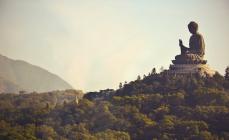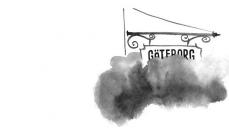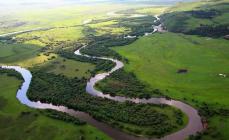For those who often visit the Sea of Azov, in particular Primorsko-Akhtarsk, Yasenskaya Spit - one of the natural attractions of these places - is perhaps the most memorable. Extraordinarily pure sea water, although not distinguished by its diversity and abundance of colors, beautiful nature and untouched by harmful human activity, a calm and measured atmosphere, attracts sophisticated tourists here.
However, it is not often possible to enjoy marvelous views - it is quite difficult to get to the spit, because it is under protection, environmentalists and border guards, which makes access to it extremely difficult. But not all of it is a protected area: one part of it has a resort status, but the most interesting is in the one that still belongs to the reserve.
Where is Yasenskaya Spit located on the map
It is divided between two districts - Yeisk (in the north) and Primorsko-Akhtarsky (in the south). The nearest settlements are Morozovsky farm and Yasenskaya ferry. Nearby you will also find what has already been described on our website.
Origin. Geography. Nature
The exact time of the formation of the Yasenskaya Spit is not known for certain: there is an assumption that its age is several millennia. There is no scientific basis for this vociferous version; referring to the geographical data relating to Azov, it means that in the period from the 5th century. BC e. according to the 1st century n. e. the current sea bore the unproud name of the Meotian swamp, and from the 1st to the 7th centuries. - Scythian lake.
The spit itself, like any other, has an alluvial character. Besides, famous geographer of antiquity, Ptolemy the Elder, who described these lands in detail, does not mention it. The most probable time of its creation is between the 15th and the beginning of the 19th centuries.

But the mechanism of its formation is well known: in fact, you do not need to have a degree, it is enough to observe the tides. This is the action of persistent western and northwestern winds, which almost never subside in this area. When they become especially ferocious, they raise the so-called "standing waves" reaching 3 m in height, falling with force on the coast.
Standing waves wash sand and shell rock chaotically, and this is where the spotter comes into play - the phenomenal features of the Sea of \u200b\u200bAzov. At the moments when the gusts of wind subside, the water rapidly moves away from the coast, this shallowing can last up to several days, and then, just as suddenly, it returns, colliding in the spit area with two separate streams, violently breaking each other. These processes are also manifested in other areas of the water area, forming spit.
Nature and features
made popular resort small district center Krasnodar Territory Primorsko-Akhtarsk Yasenskaya Spit is located 3 km northwest of it. Located in the eastern part Sea of Azov, it separates the freshwater Beisugsky estuary from the salty waters of the Yasensky Bay, becoming a kind of barrier between them.
Wagging and constantly changing direction - now to the south, then to the east, it stretched like a huge snake almost to the Yasenskaya crossing, at a distance of a little more than 14 km. The spit mainly consists of coarse-grained quartz sand, resembling ocher in color, interspersed with fine white shell rock, which prevails at the tip, resting on the girlo.
Appearance and location sand spit is constantly changing, its gradual destruction occurs, almost along its entire length, especially in the center, where it is especially unstable. Both natural and man-made manipulations have a destructive effect on it, and the influence of changing climatic conditions is also tangible.

Increasingly, in recent years, furious hurricanes have been hitting the Sea of \u200b\u200bAzov, the level is gradually increasing - these natural processes are systematically eroding the root of the spit. According to scientists, over 60 years, the Yasenskaya Spit lost 2,900,000 sq. m of its area and 7,000,000 cubic meters. m of sand, approximately 20% in total.
If the sea surface manages to break through the sand barrier and turn it into a chain of small islands, the consequences can be catastrophic. Salty water, pouring into the neighboring estuary, will transform it into a shallow Azov bay, which will cause irreparable damage to the local fish farm and lead to a deterioration in the ecological balance over a vast territory.
Interestingly, while the root section is inexorably destroyed, the northern one is steadily growing, which is facilitated by strong undercurrents and tidal waves. But the most remarkable thing here is the hook-shaped shell tip of the spit, moving under the influence of the wind, capable of turning in the opposite direction during the night.
Types of recreation on Yasenskaya Spit
The main and practically the only type of leisure that Yasenskaya Spit can offer is savage recreation. There are no chic, where prices go off scale, you will not meet and tourist camping or other vacationers, which is rather strange given the popularity of the attraction.
In a word, not the slightest manifestation of at least some kind of infrastructure simply does not exist in this place - only a bottomless blue sky, a crystal clear sea, and dense sand rustling underfoot. But you still need to get from the shore to the spit, you can do this in two ways: hire a boat in the Yasensky ferry or swim, on your own, from the road going to the Morozovsky farm.
It should be borne in mind that most of the Yasenskaya Spit is a nature reserve, except for the one reserved for the public. This explains the lack of tourists. Many rare species of protected birds live here, such as egrets, for example, and you can also meet those that are not at all familiar to our latitudes, such as pelicans.

It is not known whether it is possible to put up tents - there are no signs or prohibition signs anywhere, but lighting fires is strictly prohibited, violators will face serious fines. Pastime is endless swimming in the purest water, where, unlike the beach, there are also deep-water points, and for this you do not need to move 800 meters from the coast.
An excellent alternative to this holiday is fishing, which is highly productive. The variety of fish here is small, but the Black Sea goby is well caught, and especially the ram, which does not let you get bored. There are a lot of fishermen here, although everything also depends on the season - sometimes there is no bite at all.
How to get (get there)?
You can get to Morozovsky by bus, which runs between the farm and regularly. And from Yeysk you can easily take the minibus number 33a to the Yasenskaya Ferry.
Get to x by car. Morozovsky is most convenient in this way:
Note to the tourist
- Address: Yeysk - Primorsko-Akhtarsk, Krasnodar Territory, Russia.
- GPS coordinates: 46.214206, 38.250921.
Yasenskaya Spit is a truly wonderful place to relax, where you can have a fun and pleasant weekend, take memorable photos, go fishing and swim to your heart's content. True, at your own peril and risk, for an official stay, it is recommended to register, and few people want to do this. Reading the reviews of people who have been on the spit, they seem implausible, it is hard to believe that there are still such corners, and when you see everything with your own eyes, it seems even more unreal. In conclusion - a video clip from YouTube in the subject, enjoy watching!
The shores of the Sea of Azov within the Krasnodar Territory part 2
Primorsko-Akhtarsk - Yasenskaya Spit
The coast between the city of Primorsko-Akhtarsk and the root of the Yasenskaya spit is abrasion throughout. Average Height cliffs is 4 m, the maximum is 8 m. The coast has a scalloped structure, the capes are formed by the densest varieties of loams. The average rate of abrasion over a long period is 1.0-3.6 m/year, the maximum is up to 6.0 m/year. Coastal ledges are composed of loess-like loams and clays and practically do not provide beach-forming material.
Therefore, the abrasion terrace is only covered in places by a thin sand cover, and is bare for the most part. in the form of a concrete sloping wall with a persistent tooth at the base and a parapet along the top, enclosing the embankment. The total length of the fortified section of the coast is 3.8 km. The grouns were built from iron plates 0.15 m thick, installed between rows of piles, and interconnected into a single structure with a monolithic capped beam.
A total of 14 buns were built. Currently, the coast of Primorsko-Akhtarsk is protected by a wave wall and groins. In the central part, a gravel-sand beach up to 35 m wide has been backfilled. Also in Primorsko-Akhtarsk, a wall and an embankment were restored, an artificial pebble beach(3.8 km) from the boarding house “Lotos” to the shipyard (Fig. 6). On the eastern side, the beach is protected by three groins 30, 35 and 50 m long. The space between the groins is filled with imported pebbles 4-6 cm in diameter.
Figure 6 - Wave wall and artificial pebble beach of the tourist center "Lotos"
The coast near the Morozovsky farm south of the root of the Yasenskaya Spit is reinforced with a sloping wall with a berm along the base and a parapet along the top of the wall. The length of the fortified coast is 450 m. Construction was carried out in 1985-1986. To the south of this area begins an abrasion cliff 1.5-2 m high with a winding contour in plan (Fig. 7). Next is the second fragment of the bank protection structure (about 400 m), made of a concrete berm, a slope wall and a massive parapet with a wave-reflecting peak. The crest of the parapet rises above the mean sea level by 3.5-4.0 m (Fig. 8). The end parts of the sloping wall are washed away. 
Figure 7 - Abraded coast to the north of the Primorsko-Akhta lighthouse 
Figure 8 - Coastal fortification of the Morozovsky farm
Yasenskaya spit - the banks of the Beisug estuary
On the coast between the root of the Yasensky Spit and Art. Yasenskaya, there are two accumulative forms with common genetic features - the Yasenskaya spit and the bay of Khanskoye Lake. The Yasenskaya Spit, 18 km long, is oriented in a northeasterly direction and is formed mainly from biogenic material. The width of the beaches here does not exceed 5 m. In the middle part of the spit, the width of the beaches increases to 15–20 m, and 50 m in the distal. The biogenic material comes from the bottom. At the root of the Yasenskaya spit is reinforced with a stone berm of material 10-50 cm in diameter. Berm width 6 m, height 1-1.5 m (Fig. 9). The bay-bar of Lake Khanskoye is 25 km long and 1-2 km wide. The body of the bay-bar is 80-90% composed of shell detritus with a small admixture of sand, gravel and pebbles from the rocks of the eroded coast. The width of the beaches at the Yasenskaya crossing exceeds 30 m. 
Figure 9 - Fortified coast at the root of the Yasenskaya Spit
Beach in the village them. Tamarovsky is a turfed plateau 2-2.5 m high. Not far from the edge there is a dead cliff of the same height. The beach is shell-shaped, from 1 to 10 m wide. In the center of the village, the shore is reinforced with inclined concrete slabs. To the north-west, 1-1.5 km from the village, a steep, landslide-abrasive coast begins. The height of almost vertical cliffs composed of loess loams reaches 15 m. The coast has a pronounced scalloped structure. The beach is practically non-existent. The southeastern coast of the estuary is relatively stable, the banks are overgrown with reeds.
Yasenskaya crossing - spit Kamyshevatskaya
In the vicinity of the village The Yasenskaya crossing is low, accumulative. The beach is predominantly shell, 5-20 m wide. For 15 km to the north-west of the station. Shilovka shores are composed of loess-like loams. They are subject to active landslide-abrasion processes, screes and landslides are frequent. The height of the coastal cliff ranges from 18 m at the southern edge of the station. Kamyshevatskaya up to 7-8 m at the station. Shilovka. The beaches are narrow (5-10 m) with slopes of 0.11-0.12 . They are composed of sand, shell material, small pebbles and gravel.
Spit Kamyshevatskaya - Spit Dolgaya
Coast between st. Kamyshevatskaya and Dolzhanskaya station includes an abrasion shore (Kamyshevatskaya - Dolzhanskaya station) and two accumulative forms - Kamyshevatskaya and Dolgaya spits. The Kamyshevatskaya Spit is located on the southeastern tip of the Yeisk Peninsula. This is a flat surface with a system of ancient coastal ridges and depressions oriented from northeast to southwest. Its length is about 6 km, and the width in the root part is 4.0 km. Shell and shell detritus make up 80-95% of the composition of the material. The mineral part is represented by quartz sand, gravel and a small amount of pebbles. In recent years, the western bank of the spit has been eroded (Fig. 10), while the distal end grows and simultaneously turns towards the shore. 
Figure 10 - Western coast of the Kamyshevatskaya spit
Between Art. Kamyshevatskaya and the root of the Dolzhanskaya Spit (30 km), the root bank belongs to the abrasion-landslide type. Coastal cliffs are composed of loess-like loams, which are underlain by Scythian clays, and have a height of 7-15 m. The composition of the beach material is fine-grained sands mixed with shells. The Dolgaya Spit is located at the entrance to the Taganrog Bay. Its length is 12 km. Opposite the distal end, there is an island separated from the spit by a gully. The body of the spit is composed mainly of shell material. The width of the beaches from the side of the open sea is up to 25-40 m (Fig. 11), coastline stable. 
Figure 11 - Admiral's Quay Beach The northeastern coast of the spit is receding at a rate of 6-8 m/year.
The width of sand and shell beaches is only 1-4 m (Fig. 12). The shore in the area of the Cossack Kuren camp site and the former Rybzavod is being eroded at a rate of up to 10 m per year, some of the structures ended up on the shoreline and collapsed (Fig. 13). Protection of the coast of the rest house "Azov" at the station. Dolzhanskaya was completed without design and survey work. Initially, the bank protection was a sloping wall made of reinforced concrete slabs and about 20 short spurs 6 m long from the same slabs, placed on edge at a distance of 5 m from each other. Currently, the sloping wall and spurs are practically destroyed (Fig. 14). 
Figure 12 - The eroded northeastern coast of the Long Spit 
Figure 13 – Building on the edge as a result of bank erosion and partially collapsed building 
Figure 14 - Remains of a wave-break wall near the Azov rest house
Stanitsa Dolzhanskaya - Yeyskaya spit
In the area between st. Dolzhanskaya and the city of Yeysk there is an abrasion shore (Fig. 15). The cliffs are composed of loess-like loams, the height of which near the city of Yeisk is up to 20-26 m and 3-6 m near the station Dolzhanskaya. The beaches are narrow - 5 m, their slopes are 0.08-0.09. From Vorontsovka to Dolzhanskaya station, the abrasion coast recedes at an average rate of 1.9 m/year, maximum - up to 5.0 m/year. In the village of Vorontsovka, the height of the cliff decreases, the width of the beach varies from 3 to 25 m, but the coast continues to be actively eroded, as evidenced by the remains of coastal protection structures on the coast. In Yeysk, southwest of the root of the Yeisk Spit, a 3.5 km long coastline was fortified (Fig. 16).
The bank protection of this section was carried out in 1988-1996 as an emergency measure. A berm of pebble-boulder material was backfilled at a distance of 20-40 m from the bottom of a cliff 19-21 m high. The structure reliably covers the coast from erosion not only from ordinary storms, but also at high surge levels. The Yeisk Spit is composed of quartz sand, shell material, and detritus mixed with pebbles and gravel. The surface of the spit is built up. The width of the beaches in the distal part from the side of the estuary is 13-15 m, from the side of the Taganrog Bay - 20-30 m. The Yeysk Spit was strengthened from the side of the Taganrog Bay between the port and its distal end for a length of 1.8 km. At the end of the spit, the coast, 0.5 km long, was fortified back in the pre-war period with a wooden sheet pile wall filled with rubble. 
Figure 15 - Abrasion-landslide coast at the site of st. Dolzhanskaya - Vorontsovka 
Figure 16 - Shore protection within the city of Yeysk
The coast of the Yeisk estuary
The coastal cliffs of the Yeisk estuary are composed of loess-like loams and belong to the abrasion-landslide type with a height of 5 to 19 m. The cliffs are dissected by ravines and gullies. The width of the beaches is 4-6 m, their slopes are 0.10-0.26. On the Yeisk ledge, the coast is abrasion-landslide, intensively subjected to erosion, weathering and erosion. Bench made of Scythian clays is almost everywhere exposed. On coastal ledges of small height, landslides and screes develop, on higher ones (above 18 m) - landslides and landslides. Coastal erosion is noted on south coast estuary, where the railway Yeysk-Krasnodar passes.
To the west of the village of Shirochanka and within the city of Yeysk, the coast along the embankment railway fortified for 7 km. The bank was strengthened by the North Caucasus Railway to protect the railway track along the shore of the estuary and consists of a berm made of torn stone (3.0 km) and a retaining wall up to 1.5 m (5.5 km) high. In several places, the retaining wall is damaged, and the beach strip is absent for a significant length of the site or has a width of 1-5 m. For this reason, the strengthening of the coast is not sufficiently reliable. However, in this form, coastal protection structures ensure the stability of the coastline for 30 years.
The coastal slope is currently 80% turfed, while in the neighboring unprotected area the edge of the abrasion ledge has receded by 20 m. Alexandrovka). Shore strengthening was carried out in the early 90s to stabilize the coastline and create a recreational beach. The beach is stable, has a width of 15 m and protects the shore from abrasion. In the eastern and northeastern parts of the estuary, the coasts are relatively neutral. Loamy cliffs are separated from the shoreline by reed beds (Fig. 17). 
Figure 17 - Typical view of the coast in the area of the village.
Nikolaevka Glafirovskaya spit - Sazalnitskaya spit
Glafirovskaya spit has a length of about 7 km. The distal end is bent into the Yeisk Estuary. The beach is medium shelly, 12-20 m wide. On the surface of the spit, ancient shafts are visible, which are elongated in parallel west bank. It should be noted that the western edge of the Glafirovskaya spit is retreating at the same rate as the adjacent section of the abrasion coast, while the distal end is growing. The banks adjacent to the spit are steep, composed of loams (Fig. 18). The average height of coastal cliffs is 10-15 m, the maximum is noted near the village. Shabelskoye - 26 m. The average erosion rate is 1.4 m per year. The type of coast is abrasion-landslide. A sandy-shell beach 7-22 m wide is leaning against the foot of the abrasion cliff. In the area of the Shabelskoye village, a beach more than 20 m wide protects a high (more than 15 m) dead cliff composed of loams from the effects of waves (Fig. 19). 
Figure 18 - The root of the Glafirovskaya spit 
Figure 19 - Typical view of the coast in the area of the village. Shabelskoe
Spit Sazalnitskaya - Port-Katon
Spit Sazalnitskaya has the form of a symmetrical accumulative ledge. The length along the axis oriented to the north is 3 km, the width of the base along the extinct cliff is about 7 km. The beaches, whose width is 10-13 m in the root part and 20-25 m in the central and distal parts, are 50-60% composed of abrasion material - fine and medium-grained quartz sand, gravel, pebbles. The biogenic part of sediments is 40%, in the near-water part up to 85%. The flat surface of the spit in the northern part is disturbed by numerous cuts of "amateur" sand pits.
And in the south, near the high bedrock bank, against the mouths of the beams opening to the spit, there are slightly convex alluvial fans. The shores in the area of the Molchanovka farm are steep, composed of loams. The steep abrasion cliff with wave-cutting niches has a height of 10-12 m. The beach under the cliff ranges from 3-10 m and is composed of clay, sprinkled with sand in some places. The coast from the Molchanovka farm towards the Sazalnitskaya spit is predominantly abrasion. Sheer cliffs are composed of clays and loess-like loams. The beaches are narrow and only opposite the beams their width increases, they are composed of sand and shells. On the northern segment of the site to the village. Port-Katon ledge landslide. There are constantly active landslides, in front of each large landslide in the sea there is a shoal, composed of Apsheron clays. The height of the cliff is up to 45 m. Stepwise landslides are observed. The beaches are narrow, their width increases to 15-20 m opposite the beams.
Conclusion
Four main types of coast are considered: abrasion, abrasion-landslide, accumulative and neutral. The length of the abrasion shores is 227 km, and the accumulative ones are 230 km long. Relatively stable coast has a length of 116 km. A feature of the modern dynamics of the eastern and northeastern shores of the Sea of Azov is the predominance of abrasion and the local nature of accumulation. Erosion affects not only bedrock shores, but also accumulative forms. The erosion of unique Azov braids which are of great value in terms of recreation.
For a considerable length Azov coast landslide processes are actively taking place. The average coast erosion rate reaches 3-4 m/year, the maximum rate is up to 6-8 m/year. Significant surge fluctuations in the level to a large extent enhance the abrasion effect of storm waves on the coast. It also contributes to geological structure shores composed mainly of loess-like loams and clays. When such rocks are washed away, they are almost completely washed out and carried out in the form of suspension into the deep-water zone of the sea, without providing material for the formation of beaches.
This causes high rates of coastal abrasion even with relatively weak wave action. The accumulative type of coast is represented by coasts that are very diverse in structure, genesis, and modern dynamics. Their morphology is somehow related to the sources of material and its composition, the regime of waves and alongshore currents. Accumulative forms are widespread, which are fed by bottom sediments - the bay-bar of Lake Khansky, Beisugsky and Akhtanizovsky estuaries.
Neutral shores are identified, where at present abrasion or accumulation processes are not clearly expressed. Their total length is 116 km. They are usually distributed in estuaries and in areas blocked by spits, as well as between the mouths of the river. Channels and Kuban. It should be noted that the term "neutral" is applicable only in the sense of a relatively weak impact of waves directly on the coast. At the same time, for most of them, especially in the interfluve of the Kuban and the Protoka, the coastline is receding, which is explained by the relative rise in sea level and other processes.
To stabilize the abrasion shores, protective measures are required for about 45 km. This is, first of all, a high clay cliff within the city of Yeysk and further towards the Dolgaya Spit, some areas within the boundaries settlements from the root part of the Glafirovskaya spit to Molchanovka, as well as sections of the abrasion coast between the Dolgaya and Kamyshevatskaya spits. To date, on the surveyed part of the coast of the Sea of Azov, coastal protection work has been carried out at 12 sites (33 km). The volume of implementation of coastal protection measures is only within 5-10% of the previously planned.
The implementation of coastal protection measures did not lead to stabilization of the coast in all cases. In some areas, the complex of bank protection structures is completely or partially destroyed. The protection of the main stretch of the coast is solved with the help of slope fortifications of various designs, without taking into account the width of existing beaches and the impact of the designed structures on their future state. At the same time, not enough attention was paid to the preservation or improvement of the coastal landscape. In the future, when developing and implementing coastal protection measures on the coast of the Sea of Azov, it is necessary to carry out predictive assessments of the development of the coast in natural conditions and after carrying out coastal protection measures, taking into account the existence of lithodynamic systems.
City Primorsko-Akhtarsk located on the coast of the Sea of Azov, in the Krasnodar Territory, near the Akhtar Estuary (Russia). The city is a regional center - Primorsko-Akhtarsky district. Nearby is Beysug Estuary, in general, Primorsko-Akhtarsk is located among many estuaries, there are deposits nearby therapeutic mud. Until the 18th century, there was a Turkish fortress on the territory of Primorsko-Akhtarsk Akhtar-Bakhtar, which was captured by Russian troops in 1774. This is a fairly well-known Azov resort in Russia, there is a good sea and beaches, many boarding houses and recreation centers. In this resort town you can find inexpensive housing, affordable prices, there are rooms with private facilities. Recreation in Primorsko-Akhtarsk can be very diverse, there are private boarding houses, hotels, well-developed recreation infrastructure.
Some recreation centers and boarding houses in Primorsko-Akhtarsk: recreation center "Azak", "Breeze", "Wave", hostel "Lotus", "Meotida", "Venice", "Kirpili", there is a campsite and a tent city. Not far from Primorsko-Akhtarsk, also on the shores of the Sea of Azov is located farm Morozovsky. Morozovsky is not yet particularly known as resort village, but you can also find accommodation there and stay on summer rest. Especially good for lovers of semi-wild recreation.
Satellite map of Primorsko-Akhtarsk - wikimapia.org (Sea of Azov, Primorsko-Akhtarsk)
Weather forecast and current weather in Primorsko-Akhtarsk -
1. Let's go to Akhtari!
Attention! Shuttle Buses Kanevskaya - Primorsko-Akhtarsk canceled. At 7 am, a certain minibus costing 150 rubles left for the PA from Kanevskaya. You could say lucky. Taxis, of course, are available, but this pleasure is not cheap. So it's better to go by train to Timashevskaya, and there you can get to the place on some passing bus. The ticket price is also around 150 rubles, the travel time is about 2 hours. The bus station and the railway station both in Kanevskaya and Timashevskaya are located in the neighborhood. In Timashevskaya, next to the train stations, there is a Magnit hypermarket with huge queues at the cashier.
2. Primorsko-Akhtarsk, aka Akhtari (stress on the last syllable).
It is a predominantly rural town, quite green and clean. Tamarovsky Street runs through the city center, which starts at the bus station. Perpendicular to it through 3 quarters is the street. Proletarskaya, where the market and shops are located, incl. Supermarket Magnet. Further this street leads to the sea. On the right on the embankment is an armored boat. The sea to the right of this monument is rather muddy, apparently, somewhere at the bottom of the silt deposit. To the left, towards the fish factory, it is quite swimmable and not too small. On the beach, sand mixed with shell rock and pebbles.
There are several cafes on the embankment, incl. "At the Platanus" and "Tourist". The first has a good varied menu, the second is an inexpensive diner, but you can also dine there. On st. 50 Let Oktyabrya also has a good fast food cafe and other catering establishments.
Of the attractions - the Museum of History and Local Lore (next to the bus station), the idle railway station Akhtari, the mound "Suvorovskaya Gorka" on Limannaya Street, the church in the city center, various monuments, incl. WWII heroes.
Most housing is rented on the streets between the bus station and the sea. So you don't have to go very far. There is a tourist accommodation service near the bus station. You can go there to find the right option.
3. Farm Morozovsky.
In 20 km from the PA, at the very beginning of the Yasenskaya Spit, there is the Morozovsky farm. It's small
a settlement where there are no cafes, only shops.
The sea is very clean, but smaller than in PA. First, along this very thing, then for a long time to the waist and only then to the neck. The bottom is sandy, on the shore - shell rock.
There is an equipped beach of the Yasensky camping, various drinks, ice cream and so on are sold. Further along the spit wild beach the water is also very clean. There are few apartments for rent in Morozovsky. Basically, people come there from neighboring villages in their cars. The farm itself is fenced off from the sea waves by a long concrete embankment-breakwater, along which it is good to walk in the evening.
Morozovsky has a very clean environment. therefore, there are a lot of fish, various birds, as well as mosquitoes: (However, during the day there are no mosquitoes on the sea.
4. Yasensky spit.
The 14-kilometer spit runs between the Yasensky Bay of the Sea of Azov and the Beisug Estuary.
At the end of the spit there is a wide and deep mouth of the estuary with a fast current. There is no crossing to the village of Yasenskaya crossing (Although apparently this is a good place to relax, since the sea in the vicinity of the village is clean and deep.
A little more about the festival
The creative intellectual club "Ascent" is the organizer of the festival of the author's song "Yasenskaya Spit" Morozovsky farm on Yasenskaya Spit.
1995, month of August. The first festival of author's song and poetry is held on Yasenskaya Spit, which was organized and held by members of the "ASCENT" club. A group of enthusiasts took up this difficult task.
Goals and objectives: promoting tourism as a healthy lifestyle, strengthening and developing cultural and creative ties between Krasnodar Territory, regions of Russia, the CIS, the popularization of author's songs and poetry, the identification of new talents, the involvement of young people in the movement of the joint venture and AP.
Accommodation conditions: Three days accommodation in conditions campground on the shores of the Sea of Azov on the Yasenskaya Spit. Food supplies with you. You can cook on fires, gas stoves. Products can be bought in the farm or in the city, which are not so close.

|

|






